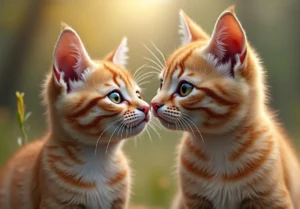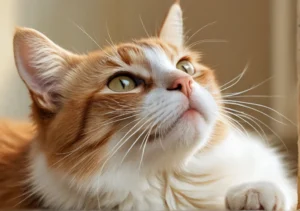Cats are known for their unpredictable behavior, often leaving their owners puzzled by their sudden jolts and bursts of energy throughout the day. But why do cats exhibit this behavior? Let’s explore the reasons behind why cats jolt during the day.
Cats jolting during the day can be attributed to a variety of factors, including their natural instincts, playfulness, and need for exercise. Understanding these reasons can help cat owners better care for their feline friends and provide them with a happy and healthy life.
The Hunting Instinct: Why do cats exhibit jolting behavior?
Cats are natural-born hunters, with a keen instinct for stalking and pouncing on prey. This hunting behavior is deeply ingrained in their DNA, influencing their actions throughout the day. When you see your cat suddenly jolting or darting across the room, it could be a manifestation of their hunting instinct kicking in.
These sudden bursts of energy and movement mimic the behavior of a cat on the prowl, ready to catch its next meal. Even though your cat may not be hunting actual prey in your living room, the instinct to chase and capture is still very much present. So, the next time your feline friend darts around the house, know that it’s just their inner hunter coming to life.
Playful Nature: How does playfulness contribute to cats jolting?
In addition to their hunting instinct, cats are also known for their playful nature. They love engaging in interactive playtime, which often involves chasing after toys, leaping around, and engaging in mock battles. This playfulness contributes to their jolting behavior as it provides an outlet for their energy and stimulates their natural instincts.
When a cat suddenly jolts or zooms around the house, it could be a result of pent-up energy or simply the desire to have some fun. Engaging in regular play sessions with your cat can help channel their playful energy in a positive way and reduce the likelihood of them exhibiting jolting behavior at inconvenient times.
Key Tip: Providing your cat with a variety of toys and interactive play sessions can help satisfy their playful instincts and reduce jolting behavior.
By understanding the hunting instinct and playful nature of cats, you can better comprehend why they exhibit jolting behavior and find ways to enrich their environment to cater to their natural tendencies. Remember, a happy and fulfilled cat is more likely to display healthy and manageable behavior throughout the day.
Exercise Needs: Why is it important for cats to jolt and play during the day?
Cats may exhibit jolting behavior during the day as a way to get the exercise they need to stay healthy and maintain their overall well-being. Physical activity is crucial for cats to prevent obesity, improve circulation, and enhance muscle tone. By jolting and playing, cats can release pent-up energy, stimulate their minds, and prevent boredom.
Moreover, engaging in play sessions can strengthen the bond between cats and their owners. Interactive playtime also helps cats build confidence, alleviate stress, and exhibit natural hunting behaviors. So next time you see your cat jolting around the house, consider joining in on the fun and engaging them in some interactive play to keep them happy and healthy.
Environmental Stimuli: What external factors can trigger cats to jolt?
There are various environmental stimuli that can trigger cats to exhibit jolting behavior during the day. One significant factor is sudden loud noises, such as a door slamming or thunderstorms, which can startle cats and cause them to run or jolt around the house. Additionally, fast movements, like a toy being tossed or a laser pointer’s light, can provoke cats to engage in playful jolting behavior.
Introducing new objects or changes in the environment, such as moving furniture or rearranging rooms, can also prompt cats to jolt as they explore and adapt to the novelty. These external factors can trigger a cat’s natural instinct to investigate, stalk, or hunt, leading to moments of jolting and high activity levels. So be mindful of your cat’s surroundings and provide them with a stimulating environment to support their natural behaviors.
- Provide scratching posts: Cats love to stretch and scratch, so having designated scratching posts can help redirect their energy in a positive way.
- Rotate toys: Switching up your cat’s toys regularly can keep them engaged and prevent boredom-induced jolting behavior.
- Interactive feeders: Use puzzle feeders or hiding treats around the house to encourage your cat to move around and stay active.
- Cat trees: Offering vertical space for climbing and perching can satisfy your cat’s innate need to explore and survey their surroundings.
- Playtime: Engage your cat in regular play sessions to provide them with mental stimulation and physical exercise.
Remember that understanding your cat’s need for exercise and attention can lead to a harmonious living environment for both you and your feline companion.
Behavioral Issues: Could jolting be a sign of underlying behavioral issues?
If you notice your cat jolting during the day, it could be a sign of underlying stress, anxiety, or other behavioral issues. Cats may exhibit this behavior as a response to feeling overwhelmed or threatened in their environment. It’s essential to observe your cat’s overall demeanor and look for any other signs of distress, such as excessive grooming, hiding, or aggression.
One potential explanation for jolting behavior could be a lack of environmental enrichment. Cats are natural hunters and need mental and physical stimulation to stay happy and healthy. Ensure your cat has plenty of interactive toys, scratching posts, and vertical spaces to explore. Creating a stimulating environment can help reduce stress and prevent jolting behavior.
If you suspect that your cat’s jolting is due to behavioral issues, consider consulting with a veterinarian or a certified animal behaviorist for professional guidance. They can help you identify the underlying cause of the behavior and develop a tailored plan to address it effectively.
Preventing Excessive Jolting: How can cat owners help manage their cat’s jolting behavior?
To help manage your cat’s jolting behavior, try incorporating regular play sessions into their daily routine. Interactive play not only provides physical exercise but also stimulates your cat’s natural hunting instincts. Use toys that mimic prey animals to engage your cat in active play sessions.
Establish a consistent feeding schedule to provide structure and predictability for your cat. This can help reduce anxiety and stress, which may contribute to jolting behavior. Additionally, ensure your cat has a quiet and safe space where they can retreat if they feel overwhelmed.
Consider using pheromone diffusers or calming supplements to help alleviate your cat’s stress and anxiety. These products can provide a sense of security and relaxation for your feline friend. Remember to consult with your veterinarian before introducing any new supplements or medications to your cat’s routine.
Lastly, make sure your cat receives regular check-ups to rule out any underlying medical conditions that could be causing jolting behavior. A thorough examination by a veterinarian can help ensure your cat stays healthy and happy.
Additional Unique Insight: – Implement vertical spaces: Cats love to climb and perch up high. Providing vertical spaces like cat trees, shelves, or window perches can give your cat a sense of security and territory, reducing stress and the likelihood of jolting behavior. Optimize your living space to accommodate your cat’s natural desire to be up high.
Interactive Playtime: Why is interactive playtime crucial for cats?
Interactive playtime is essential for cats to satisfy their natural instincts and prevent excessive jolting during the day. Engaging in play helps cats to release pent-up energy, stay mentally stimulated, and maintain a healthy weight. It also strengthens the bond between you and your feline friend.
When you play with your cat, you are providing them with much-needed physical exercise and mental enrichment. Interactive toys like feather wands, laser pointers, and puzzle feeders mimic hunting behaviors, keeping your cat engaged and active. This type of play helps to prevent boredom and reduces the likelihood of destructive behavior.
Additionally, interactive playtime can alleviate stress and anxiety in cats, promoting overall well-being. By spending quality time engaging in play with your cat, you are meeting their instinctual needs and ensuring they lead a happy and fulfilling life. So, grab a toy and get ready to have some fun with your furry companion!
Fun Facts About Cat Behavior
Cat Yawning
– Cats often yawn when they are bored or tired, just like humans. It’s a sign that they may need some stimulation or rest.Kneading
– When cats knead with their paws, it’s a throwback to kittenhood when they kneaded their mother’s belly to stimulate milk flow. It’s a comforting behavior for adult cats.Whisker Communication
– Cats use their whiskers to communicate their mood and navigate their surroundings. If a cat’s whiskers are pointed forward, they are curious or excited.Tail Position
– A cat’s tail position can indicate their mood. A raised tail signifies a happy or confident cat, while a puffed-up tail signals fear or agitation.Purring
– Cats purr not only when they are happy but also when they are in pain or distress. It can be a self-soothing behavior for cats in stressful situations.
These fun facts about cat behavior shed light on the intricate and fascinating world of our feline friends. Understanding these behaviors can help strengthen your bond with your cat and enhance their well-being. Enjoy uncovering the mysteries of your cat’s unique behaviors!
Alex, a passionate animal lover, has experience in training and understanding animal behavior. As a proud pet parent to two dogs and three cats, he founded AnimalReport.net to share insights from animal experts and expand his knowledge of the animal kingdom.




